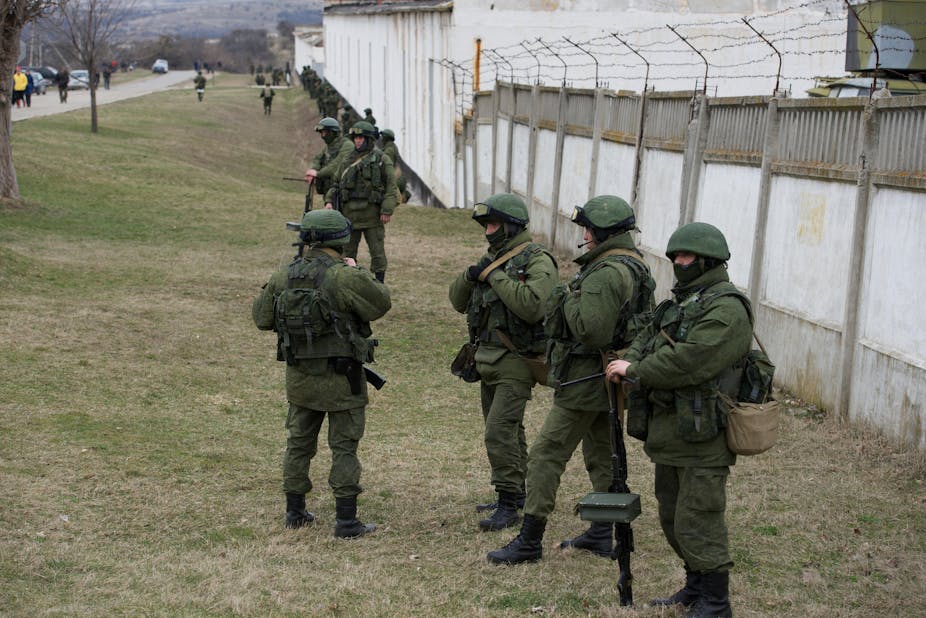A referendum was held in Crimea on March 16 2014, when the region was under military control, to ask voters whether they wanted to be part of Russia. The official result was a 96.7% vote for Russia.
At the time Crimean public buildings were held by Russian soldiers, and the military were seen across the peninsula.
The Russian authorities had cited the Kosovo precedent – where Nato had intervened against the Serbs to create a protectorate over Kosovo – for the Crimean annexation. Russia had already used this rhetoric for its invasion of its neighbour Georgia in 2008.
There was little evidence that Crimea was threatened within Ukraine and in need of an international rescue mission by Russia. But Russia under Putin had expressed concern about ethnic Russians in Crimea, and talked of its history as part of the Russian nation. Russians colonised Crimea during the reign of Catherine the Great, and founded the port of Sevastopol.
There were clear differences between Crimea and Kosovo. Crimea was not facing a threat from Kyiv. Human rights violations, as observed in Kosovo, were not being reported in Crimea.
Majority approval – if such a thing happened in Crimea – is insufficient for annexation in international law. As such, there were instantly questions about the legality of the Crimean referendum and the result. Yet the example of Kosovo reappeared as justification for the 2022 invasion of Ukraine.
Judging western reaction
The annexation of Crimea and Russia’s narrative about why it had the right to the territory raised policy and political challenges for Europe and the wider western world. Their reaction gave Russia a particular view of what it could do without a significant international pushback, which was to have massive ramifications for wider Ukraine.
Russia gained the perception that the west was weak and could be challenged. It precipitated increased use of nationalist rhetoric. Russia also quickly sought a greater global role for itself, epitomised by the intervention in Syria.

Putin had already seen Russia as challenging the west before the annexation, but Crimea emboldened Russia. This, coupled with the limited western sanctions over Russia’s role in the shooting down of the Malaysian flight MH17 and US president Barack Obama’s failure to respond militarily to Bashar Al-Assad’s use of chemical weapons in Syria, led to a Russian perception that it could push the west further without ramifications.
Russia learnt from the Crimea annexation. A referendum was used again in September 2022 when Russia illegally annexed four new territories from Ukraine.
How annexation began
On February 27 2014, “little green men” dressed in khaki and carrying guns appeared on Ukraine’s Crimean peninsula and began taking control of key military bases and the regional parliament in Simferopol. A pro-Russian government under Russian nationalist Sergei Aksyonov was quickly installed.
At the time, the Russian government said the men were “local self-defence forces”. However, a year after Crimea’s annexation Putin admitted that the men were Russian soldiers.
Having dissolved the regional government and set up a more malleable administration, the Russian authorities proposed holding a referendum on Crimea’s status. Aksyonov said the referendum should be fast-tracked. The reason given was that there had been “disorders with firearms”.
The referendum choice was changed from greater autonomy in Ukraine to including the seceding of Crimea to Russia.
What did Crimean people want?
The result of 96.7% of Crimean people voting to join Russia always looked suspect.
There are plenty of signs that those who were involved in the March 16 referendum knew the whole thing was a farce. Igor Girkin, a former Russian army and security services officer involved in the Crimean annexation – and subsequent war in Donbas – said that the referendum was a sham.
A report posted on the president of Russia’s council on civil society and human rights website – which was taken down almost immediately – stated that the participation was likely far less than 50%. Putin has admitted the Crimean annexation was ordered weeks before the referendum and that Russian soldiers were deployed “to help the inhabitants express their opinion”.
The options on the ballot were joining Russia or reverting to the 1992 autonomy statute. The latter gave the Crimean parliament the power to secede to Russia, an option deputies had already stated would happen if Crimeans didn’t vote the “right” way.
Previous polls may give some indications of Crimean feelings. From 2008 to 2011 the number of Crimean residents who saw Ukraine as their motherland rose from 32% to 71.3%, according to one report. An International Republican Institute poll in 2013 found that 53% of Crimeans wanted autonomy within Ukraine and 23% wanted to join Russia.
Two days before the referendum, a poll found 70% claiming that they’d vote to join Russia. If respondents were given other options – like an independent Crimea – support for joining Russia fell to 53.8%.
However, US academics found that 85% of Crimeans believed Crimea was moving in the right direction a year after annexation.
Indications for Putin
The Crimean annexation set up the Ukraine war. America’s messy withdrawal from Afghanistan further emphasised western weakness in Putin’s mind. This, combined with inaccurate intelligence from his security services, made Putin think that having successfully pulled off an event like Crimea he could do something bigger for the rest of Ukraine in 2022.
Russia’s war on Ukraine in 2022 has fundamentally changed the world. The west has never been more united than it is over Ukraine. This unity didn’t exist after the Crimea invasion, but if it had the war might have been avoided.

